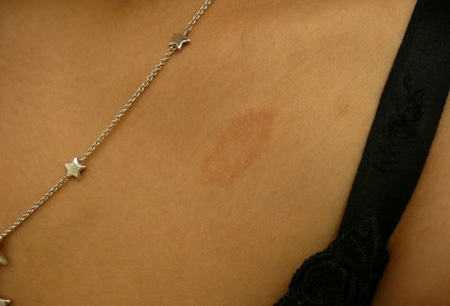Clinical features
Lesions present mostly on the trunk and upper extremities.[12]Chuh A, Chan H, Zawar V. Pityriasis rosea - evidence for and against an infectious aetiology. Epidemiol Infect. 2004 Jun;132(3):381-90.
http://www.ncbi.nlm.nih.gov/pubmed/15188706?tool=bestpractice.com
Less commonly, the face, palms, and soles of the feet may be affected, although this can be seen more often in children.[3]Trager JD. What's your diagnosis? Scaly pubic plaques in a 2-year-old girl - or in an "inverse" rash. J Pediatr Adolesc Gynecol. 2007 Apr;20(2):109-11.
http://www.ncbi.nlm.nih.gov/pubmed/17418397?tool=bestpractice.com
[4]Chuh A, Lee A, Zawar V, et al. Pityriasis rosea - an update. Indian J Dermatol Venereol Leprol. 2005 Sep-Oct;71(5):311-5.
http://www.ijdvl.com/article.asp?issn=0378-6323;year=2005;volume=71;issue=5;spage=311;epage=315;aulast=Chuh
http://www.ncbi.nlm.nih.gov/pubmed/16394453?tool=bestpractice.com
[12]Chuh A, Chan H, Zawar V. Pityriasis rosea - evidence for and against an infectious aetiology. Epidemiol Infect. 2004 Jun;132(3):381-90.
http://www.ncbi.nlm.nih.gov/pubmed/15188706?tool=bestpractice.com
The characteristic "herald patch," found in up to 80% of cases, is the largest lesion and the first to arise, usually on the trunk.[4]Chuh A, Lee A, Zawar V, et al. Pityriasis rosea - an update. Indian J Dermatol Venereol Leprol. 2005 Sep-Oct;71(5):311-5.
http://www.ijdvl.com/article.asp?issn=0378-6323;year=2005;volume=71;issue=5;spage=311;epage=315;aulast=Chuh
http://www.ncbi.nlm.nih.gov/pubmed/16394453?tool=bestpractice.com
[8]Leung AKC, Lam JM, Leong KF, et al. Pityriasis rosea: an updated review. Curr Pediatr Rev. 2021;17(3):201-11.
http://www.ncbi.nlm.nih.gov/pubmed/32964824?tool=bestpractice.com
It begins as a single papule and expands into a pink erythematous oval patch or plaque up to 10 cm in diameter. Typically it has a raised border with free edge inside (collarette) and a central scale.[3]Trager JD. What's your diagnosis? Scaly pubic plaques in a 2-year-old girl - or in an "inverse" rash. J Pediatr Adolesc Gynecol. 2007 Apr;20(2):109-11.
http://www.ncbi.nlm.nih.gov/pubmed/17418397?tool=bestpractice.com
[7]Gonzalez LM, Allen R, Janniger CK, et al. Pityriasis rosea: an important papulosquamous disorder. Int J Dermatol. 2005 Sep;44(9):757-64.
http://www.ncbi.nlm.nih.gov/pubmed/16135147?tool=bestpractice.com
[12]Chuh A, Chan H, Zawar V. Pityriasis rosea - evidence for and against an infectious aetiology. Epidemiol Infect. 2004 Jun;132(3):381-90.
http://www.ncbi.nlm.nih.gov/pubmed/15188706?tool=bestpractice.com
Occasionally multiple herald patches may be seen.[17]Mayfield J, Solomon M, Plamoottil CI, et al. Childhood pityriasis rosea with multiple herald patches. Cureus. 2020 Aug 19;12(8):e9876.
https://www.ncbi.nlm.nih.gov/pmc/articles/PMC7500735
http://www.ncbi.nlm.nih.gov/pubmed/32963916?tool=bestpractice.com
This is followed by an eruption of smaller papulosquamous oval lesions after 7 to 10 days, although a delay of up to 84 days has been reported.[4]Chuh A, Lee A, Zawar V, et al. Pityriasis rosea - an update. Indian J Dermatol Venereol Leprol. 2005 Sep-Oct;71(5):311-5.
http://www.ijdvl.com/article.asp?issn=0378-6323;year=2005;volume=71;issue=5;spage=311;epage=315;aulast=Chuh
http://www.ncbi.nlm.nih.gov/pubmed/16394453?tool=bestpractice.com
The long axes of these oval lesions are aligned along lines of skin cleavage ("Langer lines") on the trunk, creating a fir-tree pattern of branches with the spine as the trunk, a V distribution over the chest and upper back, circumferentially over the shoulders and hips, and a horizontal distribution over the lower trunk.[3]Trager JD. What's your diagnosis? Scaly pubic plaques in a 2-year-old girl - or in an "inverse" rash. J Pediatr Adolesc Gynecol. 2007 Apr;20(2):109-11.
http://www.ncbi.nlm.nih.gov/pubmed/17418397?tool=bestpractice.com
[7]Gonzalez LM, Allen R, Janniger CK, et al. Pityriasis rosea: an important papulosquamous disorder. Int J Dermatol. 2005 Sep;44(9):757-64.
http://www.ncbi.nlm.nih.gov/pubmed/16135147?tool=bestpractice.com
Pruritus is a feature in 75% of patients and is moderate to severe in 50% of patients.[7]Gonzalez LM, Allen R, Janniger CK, et al. Pityriasis rosea: an important papulosquamous disorder. Int J Dermatol. 2005 Sep;44(9):757-64.
http://www.ncbi.nlm.nih.gov/pubmed/16135147?tool=bestpractice.com
[12]Chuh A, Chan H, Zawar V. Pityriasis rosea - evidence for and against an infectious aetiology. Epidemiol Infect. 2004 Jun;132(3):381-90.
http://www.ncbi.nlm.nih.gov/pubmed/15188706?tool=bestpractice.com
Infrequently, there can be oral lesions including petechiae, erosions, ulcers, vesicles, papules, and strawberry tongue, with petechiae and erosions/ulcerations being most common.[18]Alzahrani NA, AlJasser MI. Geographic tonguelike presentation in a child with pityriasis rosea: case report and review of oral manifestations of pityriasis rosea. Pediatr Dermatol. 2018 Mar;35(2):e124-7.
http://www.ncbi.nlm.nih.gov/pubmed/29436009?tool=bestpractice.com
In a small proportion of cases (5%), prodromal symptoms may be reported, including fever, malaise, headache, and arthralgia.[2]Dyer JA. Childhood viral exanthems. Pediatr Ann. 2007 Jan;36(1):21-9.
http://www.ncbi.nlm.nih.gov/pubmed/17269280?tool=bestpractice.com
[3]Trager JD. What's your diagnosis? Scaly pubic plaques in a 2-year-old girl - or in an "inverse" rash. J Pediatr Adolesc Gynecol. 2007 Apr;20(2):109-11.
http://www.ncbi.nlm.nih.gov/pubmed/17418397?tool=bestpractice.com
[7]Gonzalez LM, Allen R, Janniger CK, et al. Pityriasis rosea: an important papulosquamous disorder. Int J Dermatol. 2005 Sep;44(9):757-64.
http://www.ncbi.nlm.nih.gov/pubmed/16135147?tool=bestpractice.com
As recurrences can occur, a previous history of PR may be reported.[12]Chuh A, Chan H, Zawar V. Pityriasis rosea - evidence for and against an infectious aetiology. Epidemiol Infect. 2004 Jun;132(3):381-90.
http://www.ncbi.nlm.nih.gov/pubmed/15188706?tool=bestpractice.com
[Figure caption and citation for the preceding image starts]: Herald patch in classic distribution on the upper torsoFrom the collection of Daniela Kroshinsky, MD, MPH; used with permission [Citation ends].
Additional laboratory investigations
If infectious etiology is suspected, for example fever, malaise, and sore throat, antistreptolysin O titers may be measured to exclude streptococcal infection and/or guttate psoriasis. If only a few lesions are present, potassium hydroxide (KOH) prep microscopy or fungal culture may be performed to exclude fungal infection, such as Tinea. Consider serology for Treponema pallidum in selected patients. This includes patients at risk for secondary syphilis, and cases with atypical lesions or with palmoplantar involvement.[19]Chuh AA, Molinari N, Sciallis G, et al. Temporal case clustering in pityriasis rosea: a regression analysis on 1379 patients in Minnesota, Kuwait, and Diyarbakir, Turkey. Arch Dermatol. 2005 Jun;141(6):767-71.
http://jamanetwork.com/journals/jamadermatology/fullarticle/395163
http://www.ncbi.nlm.nih.gov/pubmed/15967925?tool=bestpractice.com
[20]Cooper M. Diseases of the epidermis: pityriasis rosea, lichen planus, keratosis pilaris. Dermatol Nurs. 2005 Dec;17(6):457-8.
http://www.ncbi.nlm.nih.gov/pubmed/16463931?tool=bestpractice.com
